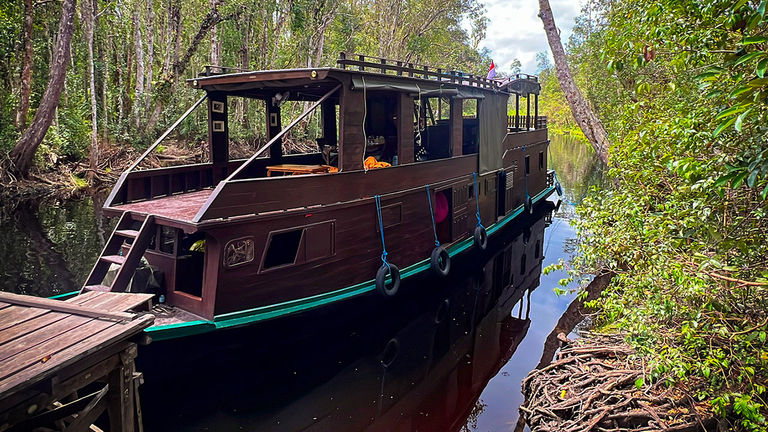Hiking down a rainforest trail in Indonesia’s Tanjung Puting National Park, it wasn’t long before I spotted in the distance the creature I had journeyed all the way to Indonesian Borneo to see. An orangutan mother was carrying her infant on her back and walking down the boardwalk of a research camp in the middle of the jungle. As the general rule goes with most wild, yet tame, animals, you’re not to approach them, but they have free range to approach you — and eventually, the orangutans’ initial distance of about 30 yards diminished as they got closer and closer to me.
But suddenly, another orangutan appeared behind them — walking not toward my camera lens, but to one of the researcher’s shelters, which happened to have laundry hanging outside to dry. I watched as the orangutan took a pair of denim trousers and tried putting it on, one leg at a time, in a clumsy way — but with no luck. Humans may share 97% of genes with orangutans, but not all jeans across every primate are a perfect fit, I guess.
The mother and child eventually walked right past me on their way to the feeding platform at Camp Leakey, named after Dr. Louis Leakey, the late paleoanthropologist. It’s one of three accessible camps in Tanjung Puting National Park where many formerly captive orangutans are released after a rehabilitation period.
Nowadays, these camps are primarily for researchers, rangers and daytime tourists since there are still daily feeding times at each one, during which fruits are simply laid out on a large, elevated platform for the taking. Semi-wild orangutans come on their own to the feeding, enjoying an easy meal as they transition into the wild. Eventually, most of them become independent and learn to forage for themselves without help.
Witnessing orangutans coming to a feeding — or even the rarer sighting of one trying to put on a pair of jeans — is the highlight of an orangutan trekking tour in Borneo. This island, which is shared by Indonesia, Malaysia and Brunei, is one of only two places in the world where wild orangutans exist. To see their human-like eyes — as well as their hands and mouths as they peel and eat mangoes like a person — is an awe-inspiring experience.
How to Get There
To have an orangutan encounter in Borneo involves sailing on a traditional wooden river boat (called a klotok) as it travels from jetty to jetty along the Sekonyer River. This waterway is the main thoroughfare in Tanjung since there are no developed roads in this remote part of the rainforest.
There are dozens of klotoks from different eco-tour companies in the park, and many are the traditional length of about 40 feet, but with different configurations. I was onboard the Jungle Papa, the klotok belonging to Orangutan Trekking Tours. The boat had modest, yet private, quarters, with air conditioning whenever the boat was docked at night near a camp or village and could easily plug into an electrical source.
 Orangutan Trekking Tours’ Jungle Papa riverboat.
Orangutan Trekking Tours’ Jungle Papa riverboat.
Credit: 2023 Erik TrinidadWhat to Expect
Booking with Orangutan Trekking Tours is a fairly straightforward and pleasant affair. The company has a courteous, attentive client desk based out of Australia, which can help figure out flights to Pangkalan Bun, the gateway airport to the national park.
From Pangkalan Bun, Arbain — a local guide, conservationist and partner in the company — picks up and escorts guests to the Jungle Papa, which cruises onward to Tanjung Puting National Park a couple of hours away. Then, for the next three to four days, Arbain shares the sights of the jungle as clients observe orangutans and other creatures in the wild, including curious gibbons, mischievous macaque monkeys and my new favorite species, Borneo’s endemic proboscis monkey. This light brown, social monkey is known for its big, odd-looking nose and comical expressions.
 Proboscis monkeys are endemic to this part of Borneo.
Proboscis monkeys are endemic to this part of Borneo.
Credit: 2023 Logan/stock.adobe.comAt Camp Leakey, orangutans regularly congregated at the feeding platform for the daily meal. Some simply came to grab fruits and retreat into the trees, as if picking up a to-go order. Eventually, bellies became full, fruits ran out, and each ape went back into the jungle by climbing up tree trunks and swinging from branch to woody vine, until they disappeared into the rainforest foliage.
Orangutan Trekking Tours works with travel advisors — offering a small commission for repeat bookings — but the real reward for agents will be the rave reviews from clients. After all, the word “orangutan” is derived from two Malay words: orang meaning “person” and utan meaning “forest.” Orangutans are very much “people of the forest,” and well worth the journey to this remote part of the world.